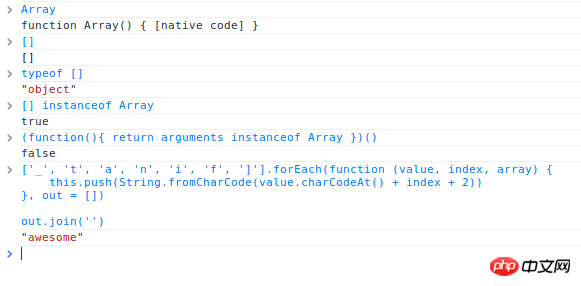詳細介紹有趣的JavaScript原生數組函數的程式碼範例
在JavaScript中,建立陣列可以使用Array建構函數,或是使用陣列直接量[],後者是首選方法。 Array物件繼承自Object.prototype,對數組執行typeof操作符傳回object而不是array。然而,[] instanceof Array也回傳true。也就是說,類別數組物件的實作更複雜,例如strings物件、arguments對象,arguments物件不是Array的實例,但有length屬性,並能透過索引取值,所以能像陣列一樣進行循環操作。
在本文中,我將複習一些陣列原型的方法,並探索這些方法的用法。
迴圈:.forEach
判斷:.some與.every
區分.join和.concat
堆疊和佇列的實作:.pop, .push, .shift,和.unshift
- ##模型映射:.map
- 查詢:.filter
- 排序:.sort
- 計算:.reduce和. reduceRight
- 複製:.slice
- #強大的.splice ##尋找:.indexOf
- 運算子:in
- 走近.reverse

- 循環:.forEach
這是JavaScript中最簡單的方法,但IE7和IE8不支援此方法。
.forEach 有一個回呼函數作為參數,遍歷數組時,每個數組元素都會呼叫它,回呼函數接受三個參數:- value:當前元素
- index:目前元素的索引
#array:要遍歷的陣列
此外,可以傳遞可選的第二個參數,作為每次函數調用的上下文(this).
['_', 't', 'a', 'n', 'i', 'f', ']'].forEach(function (value, index, array) {
this.push(String.fromCharCode(value.charCodeAt() + index + 2))
}, out = [])
out.join('')
// <- 'awesome'後文會提及.join,在這個示例中,它用於拼接數組中的不同元素,效果類似於out[0] + ” + out[1] + ” + out[2] + ” + out[n]。
注意,當回呼函數的value < 10時,中斷函數循環。 concat.join和.concat 經常混淆。一個新數組,作為來源數組的淺拷貝。 ##.concat傳回一個新數組
array.concat()在沒有參數的情況下,傳回來源數組的淺拷貝。 #淺拷貝意味著新數組和原始數組保持相同的物件引用,這通常是好事。例如:
max = -Infinity
satisfied = [10, 12, 10, 8, 5, 23].some(function (value, index, array) {
if (value > max) max = value
return value < 10
})
console.log(max)
// <- 12
satisfied
// <- true堆疊和佇列的實作:.pop, .push, .shift和.unshift
- 每個人都知道.push可以再數組末尾添加元素,但是你知道可以使用[].push('a', 'b', 'c', 'd', 'z')一次加入多個元素嗎?
.pop 方法是.push 的反操作,它會傳回被刪除的陣列結尾元素。如果陣列為空,將傳回void 0 (undefined),使用.pop和.push可以建立LIFO (last in first out)堆疊。
var a = { foo: 'bar' } var b = [1, 2, 3, a] var c = b.concat() console.log(b === c) // <- false b[3] === a && c[3] === a // <- true登入後複製模型對應:.map- .map為陣列中的每個元素提供了一個回呼方法,並傳回有呼叫結果構成的新陣列。回呼函數只對已經指定值的陣列索引執行;它不會對已刪除的或未指定值的元素呼叫。
Array.prototype.map 和上面提到的.forEach、.some和.every有相同的參數格式:.map(fn(value, index, array), thisArgument)
function Stack () { this._stack = [] } Stack.prototype.next = function () { return this._stack.pop() } Stack.prototype.add = function () { return this._stack.push.apply(this._stack, arguments) } stack = new Stack() stack.add(1,2,3) stack.next() // <- 3 相反,可以使用.shift和 .unshift创建FIFO (first in first out)队列。 function Queue () { this._queue = [] } Queue.prototype.next = function () { return this._queue.shift() } Queue.prototype.add = function () { return this._queue.unshift.apply(this._queue, arguments) } queue = new Queue() queue.add(1,2,3) queue.next() // <- 1 Using .shift (or .pop) is an easy way to loop through a set of array elements, while draining the array in the process. list = [1,2,3,4,5,6,7,8,9,10] while (item = list.shift()) { console.log(item) } list // <- []登入後複製undefined × 3很好地解釋了.map不會對已刪除的或未指定值的元素調用,但仍然會被包含在結果數組中。 .map在建立或改變陣列時非常有用,看下面的範例:
values = [void 0, null, false, '']
values[7] = void 0
result = values.map(function(value, index, array){
console.log(value)
return value
})
// <- [undefined, null, false, '', undefined × 3, undefined]查詢:.filter
filter對每個陣列元素執行一次回呼函數,並傳回一個由回調函數傳回true的元素所組成的新數組。回呼函數只會對已經指定值的陣列項呼叫。通常用法:.filter(fn(value, index, array), thisArgument),跟C#中的LINQ表达式和SQL中的where语句类似,.filter只返回在回调函数中返回true值的元素。
[void 0, null, false, '', 1].filter(function (value) {
return value
})
// <- [1]
[void 0, null, false, '', 1].filter(function (value) {
return !value
})
// <- [void 0, null, false, '']排序:.sort(compareFunction)
如果没有提供compareFunction,元素会被转换成字符串并按照字典排序。例如,”80″排在”9″之前,而不是在其后。
跟大多数排序函数类似,Array.prototype.sort(fn(a,b))需要一个包含两个测试参数的回调函数,其返回值如下:
a在b之前则返回值小于0
a和b相等则返回值是0
a在b之后则返回值小于0
[9,80,3,10,5,6].sort()
// <- [10, 3, 5, 6, 80, 9]
[9,80,3,10,5,6].sort(function (a, b) {
return a - b
})
// <- [3, 5, 6, 9, 10, 80]计算:.reduce和.reduceRight
这两个函数比较难理解,.reduce会从左往右遍历数组,而.reduceRight则从右往左遍历数组,二者典型用法:.reduce(callback(previousValue,currentValue, index, array), initialValue)。
previousValue 是最后一次调用回调函数的返回值,initialValue则是其初始值,currentValue是当前元素值,index是当前元素索引,array是调用.reduce的数组。
一个典型的用例,使用.reduce的求和函数。
Array.prototype.sum = function () {
return this.reduce(function (partial, value) {
return partial + value
}, 0)
};
[3,4,5,6,10].sum()
// <- 28如果想把数组拼接成一个字符串,可以用.join实现。然而,若数组值是对象,.join就不会按照我们的期望返回值了,除非对象有合理的valueOf或toString方法,在这种情况下,可以用.reduce实现:
function concat (input) {
return input.reduce(function (partial, value) {
if (partial) {
partial += ', '
}
return partial + value
}, '')
}
concat([
{ name: 'George' },
{ name: 'Sam' },
{ name: 'Pear' }
])
// <- 'George, Sam, Pear'复制:.slice
和.concat类似,调用没有参数的.slice()方法会返回源数组的一个浅拷贝。.slice有两个参数:一个是开始位置和一个结束位置。
Array.prototype.slice 能被用来将类数组对象转换为真正的数组。
Array.prototype.slice.call({ 0: 'a', 1: 'b', length: 2 })
// <- ['a', 'b']
这对.concat不适用,因为它会用数组包裹类数组对象。
Array.prototype.concat.call({ 0: 'a', 1: 'b', length: 2 })
// <- [{ 0: 'a', 1: 'b', length: 2 }]此外,.slice的另一个通常用法是从一个参数列表中删除一些元素,这可以将类数组对象转换为真正的数组。
function format (text, bold) {
if (bold) {
text = '<b>' + text + '</b>'
}
var values = Array.prototype.slice.call(arguments, 2)
values.forEach(function (value) {
text = text.replace('%s', value)
})
return text
}
format('some%sthing%s %s', true, 'some', 'other', 'things')强大的.splice
.splice 是我最喜欢的原生数组函数,只需要调用一次,就允许你删除元素、插入新的元素,并能同时进行删除、插入操作。需要注意的是,不同于`.concat和.slice,这个函数会改变源数组。
var source = [1,2,3,8,8,8,8,8,9,10,11,12,13] var spliced = source.splice(3, 4, 4, 5, 6, 7) console.log(source) // <- [1, 2, 3, 4, 5, 6, 7, 8, 9, 10, 11, 12 ,13] spliced // <- [8, 8, 8, 8]
正如你看到的,.splice会返回删除的元素。如果你想遍历已经删除的数组时,这会非常方便。
var source = [1,2,3,8,8,8,8,8,9,10,11,12,13]
var spliced = source.splice(9)
spliced.forEach(function (value) {
console.log('removed', value)
})
// <- removed 10
// <- removed 11
// <- removed 12
// <- removed 13
console.log(source)
// <- [1, 2, 3, 8, 8, 8, 8, 8, 9]查找:.indexOf
利用.indexOf 可以在数组中查找一个元素的位置,没有匹配元素则返回-1。我经常使用.indexOf的情况是当我有比较时,例如:a === ‘a’ || a === ‘b’ || a === ‘c’,或者只有两个比较,此时,可以使用.indexOf:['a', 'b', 'c'].indexOf(a) !== -1。
注意,如果提供的引用相同,.indexOf也能查找对象。第二个可选参数用于指定开始查找的位置。
var a = { foo: 'bar' }
var b = [a, 2]
console.log(b.indexOf(1))
// <- -1
console.log(b.indexOf({ foo: 'bar' }))
// <- -1
console.log(b.indexOf(a))
// <- 0
console.log(b.indexOf(a, 1))
// <- -1
b.indexOf(2, 1)
// <- 1如果你想从后向前搜索,可以使用.lastIndexOf。
操作符:in
在面试中新手容易犯的错误是混淆.indexOf和in操作符:
var a = [1, 2, 5] 1 in a // <- true, but because of the 2! 5 in a // <- false
问题是in操作符是检索对象的键而非值。当然,这在性能上比.indexOf快得多。
var a = [3, 7, 6] 1 in a === !!a[1] // <- true
走近.reverse
该方法将数组中的元素倒置。
var a = [1, 1, 7, 8] a.reverse() // [8, 7, 1, 1]
.reverse 会修改数组本身。
参考
《Fun with JavaScript Native Array Functions》
以上就是详细介绍有趣的JavaScript原生数组函数的代码示例的内容,更多相关内容请关注PHP中文网(www.php.cn)!

熱AI工具

Undresser.AI Undress
人工智慧驅動的應用程序,用於創建逼真的裸體照片

AI Clothes Remover
用於從照片中去除衣服的線上人工智慧工具。

Undress AI Tool
免費脫衣圖片

Clothoff.io
AI脫衣器

Video Face Swap
使用我們完全免費的人工智慧換臉工具,輕鬆在任何影片中換臉!

熱門文章

熱工具

記事本++7.3.1
好用且免費的程式碼編輯器

SublimeText3漢化版
中文版,非常好用

禪工作室 13.0.1
強大的PHP整合開發環境

Dreamweaver CS6
視覺化網頁開發工具

SublimeText3 Mac版
神級程式碼編輯軟體(SublimeText3)
 如何使用WebSocket和JavaScript實現線上語音辨識系統
Dec 17, 2023 pm 02:54 PM
如何使用WebSocket和JavaScript實現線上語音辨識系統
Dec 17, 2023 pm 02:54 PM
如何使用WebSocket和JavaScript實現線上語音辨識系統引言:隨著科技的不斷發展,語音辨識技術已成為了人工智慧領域的重要組成部分。而基於WebSocket和JavaScript實現的線上語音辨識系統,具備了低延遲、即時性和跨平台的特點,成為了廣泛應用的解決方案。本文將介紹如何使用WebSocket和JavaScript來實現線上語音辨識系
 WebSocket與JavaScript:實現即時監控系統的關鍵技術
Dec 17, 2023 pm 05:30 PM
WebSocket與JavaScript:實現即時監控系統的關鍵技術
Dec 17, 2023 pm 05:30 PM
WebSocket與JavaScript:實現即時監控系統的關鍵技術引言:隨著互聯網技術的快速發展,即時監控系統在各個領域中得到了廣泛的應用。而實現即時監控的關鍵技術之一就是WebSocket與JavaScript的結合使用。本文將介紹WebSocket與JavaScript在即時監控系統中的應用,並給出程式碼範例,詳細解釋其實作原理。一、WebSocket技
 如何利用JavaScript和WebSocket實現即時線上點餐系統
Dec 17, 2023 pm 12:09 PM
如何利用JavaScript和WebSocket實現即時線上點餐系統
Dec 17, 2023 pm 12:09 PM
如何利用JavaScript和WebSocket實現即時線上點餐系統介紹:隨著網路的普及和技術的進步,越來越多的餐廳開始提供線上點餐服務。為了實現即時線上點餐系統,我們可以利用JavaScript和WebSocket技術。 WebSocket是一種基於TCP協定的全雙工通訊協議,可實現客戶端與伺服器的即時雙向通訊。在即時線上點餐系統中,當使用者選擇菜餚並下訂單
 如何使用WebSocket和JavaScript實現線上預約系統
Dec 17, 2023 am 09:39 AM
如何使用WebSocket和JavaScript實現線上預約系統
Dec 17, 2023 am 09:39 AM
如何使用WebSocket和JavaScript實現線上預約系統在當今數位化的時代,越來越多的業務和服務都需要提供線上預約功能。而實現一個高效、即時的線上預約系統是至關重要的。本文將介紹如何使用WebSocket和JavaScript來實作一個線上預約系統,並提供具體的程式碼範例。一、什麼是WebSocketWebSocket是一種在單一TCP連線上進行全雙工
 JavaScript與WebSocket:打造高效率的即時天氣預報系統
Dec 17, 2023 pm 05:13 PM
JavaScript與WebSocket:打造高效率的即時天氣預報系統
Dec 17, 2023 pm 05:13 PM
JavaScript和WebSocket:打造高效的即時天氣預報系統引言:如今,天氣預報的準確性對於日常生活以及決策制定具有重要意義。隨著技術的發展,我們可以透過即時獲取天氣數據來提供更準確可靠的天氣預報。在本文中,我們將學習如何使用JavaScript和WebSocket技術,來建立一個高效的即時天氣預報系統。本文將透過具體的程式碼範例來展示實現的過程。 We
 簡易JavaScript教學:取得HTTP狀態碼的方法
Jan 05, 2024 pm 06:08 PM
簡易JavaScript教學:取得HTTP狀態碼的方法
Jan 05, 2024 pm 06:08 PM
JavaScript教學:如何取得HTTP狀態碼,需要具體程式碼範例前言:在Web開發中,經常會涉及到與伺服器進行資料互動的場景。在與伺服器進行通訊時,我們經常需要取得傳回的HTTP狀態碼來判斷操作是否成功,並根據不同的狀態碼來進行對應的處理。本篇文章將教你如何使用JavaScript來取得HTTP狀態碼,並提供一些實用的程式碼範例。使用XMLHttpRequest
 javascript如何使用insertBefore
Nov 24, 2023 am 11:56 AM
javascript如何使用insertBefore
Nov 24, 2023 am 11:56 AM
用法:在JavaScript中,insertBefore()方法用於在DOM樹中插入一個新的節點。這個方法需要兩個參數:要插入的新節點和參考節點(即新節點將要插入的位置的節點)。
 JavaScript與WebSocket:打造高效率的即時影像處理系統
Dec 17, 2023 am 08:41 AM
JavaScript與WebSocket:打造高效率的即時影像處理系統
Dec 17, 2023 am 08:41 AM
JavaScript是一種廣泛應用於Web開發的程式語言,而WebSocket則是一種用於即時通訊的網路協定。結合二者的強大功能,我們可以打造一個高效率的即時影像處理系統。本文將介紹如何利用JavaScript和WebSocket來實作這個系統,並提供具體的程式碼範例。首先,我們需要明確指出即時影像處理系統的需求和目標。假設我們有一個攝影機設備,可以擷取即時的影像數






